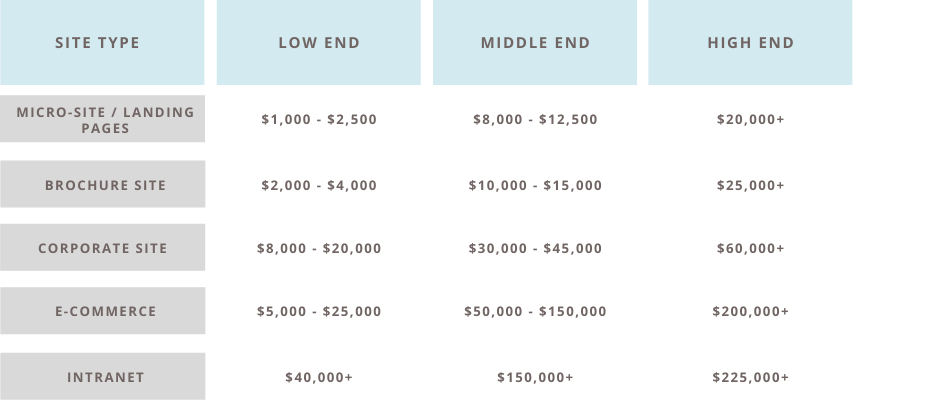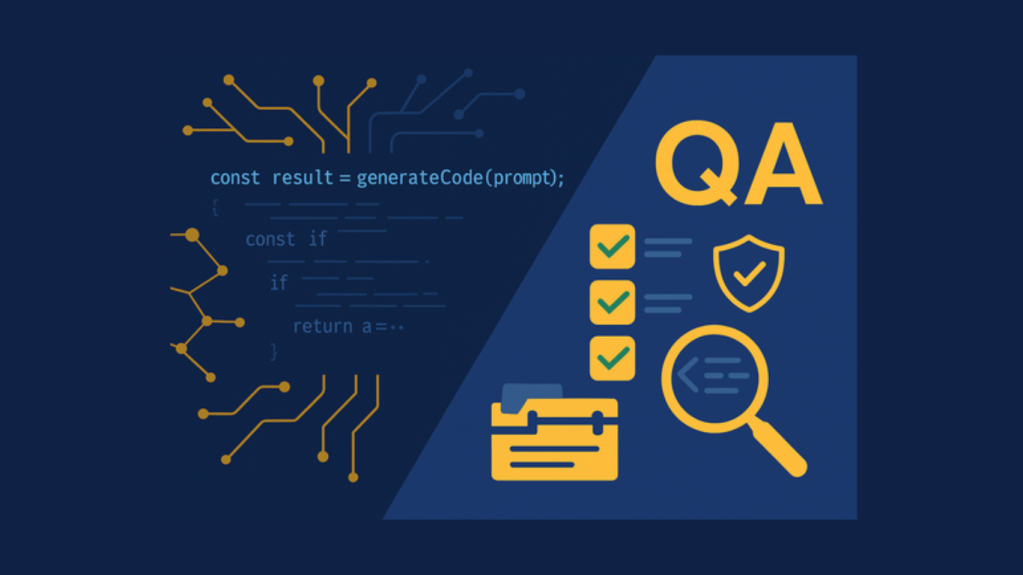When you’re considering building or re-building your website, one of the first things you’re likely to ask is “What’s this going to cost?” Typically, you’ll get an answer like “Well, it could cost anywhere from $1,000 to $300,000.” And that can be very frustrating when you’re trying to understand what the project will run. The challenge – and the reason that you’ll get a very broad range – is that a lot goes into determining the answer to that question. Below we have endeavored to explain what the variables that influence the cost of your site are, and how they impact the project’s budget.
Why it’s Hard to Answer the Question “How Much Does it Cost to Build a Website?”
Having a website for your business is as important today as having business cards was 30 years ago. It’s how customers find you, know what you do, and know how to contact you. A website can do so much more than a business card could, though. It can jump-start the relationship with the customer by building rapport or offering advice. It can provide self-service to new and existing customers. It can be a way for customers to buy directly from you. Even that is only the start. Your site can be a way for your sales team to easily get to assets. A means to onboard partners or manage shipments. It could offer a way for employees to communicate or share information. It can be how customers manage their accounts. It can also meet a variety of access needs. Someone can look at your site from their desktop, phone, tablet, or laptop. Your customers may need accessibility features. You could even have a site that offers all your information in different languages, or information tailored to different regions. All this to say – answering questions about costs requires understanding a lot of factors, including what the site is for, who it’s for, how they will view it, and even where. An experienced digital marketing and web development agency will want to get a handle on a number of factors about your site and its purpose before giving you a more specific answer. For you to understand what a website costs to build, you’ll need to wrap your head around the factors that drive website cost estimates up or down.
Do you need a better idea of how to improve your website?
Let’s Start With Common Website Costs
Before we get into the more variable costs of building a website, let’s talk first about some of the standard and ongoing costs associated with creating and keeping a website.
Domain name registration
You may already have a domain name if you’ve got a website you want to rebuild, or you may be considering creating a new one. These need to be registered through a domain registrar. $10 to $30/year
Web hosting
Hosting is where the site is going to live so that your audience can access it. How you decide to host your website will influence this cost, and will depend on how many people you think will be accessing your site, how much time you intend to spend maintaining it, how much space and processing capacity it needs, and so on. This can range from a shared hosting environment to a dedicated server. $5 to thousands of dollars a month, depending on type of hosting needed
SSL Certificates
SSL is a protocol for verifying the identity of a server and is used for encrypting internet traffic. An SSL certificate contains important information about the site, the domain name, who the certificate was issued to, the public encryption key, and more. If you won’t be selling things on your site, you may be wondering why you need an SSL certificate. Part of what an SSL certificate does is verifies that a client is connected to the correct server – the one that holds the domain for the site. Visitors won’t wonder if your site is attached to a legitimate business or not. Addresses for sites with an SSL certificate start with HTTPS. Those without start with HTTP (no S) and browsers have started tagging these sites as dangerous or not secure. You may not need encryption, but having a browser warn clients away from your site is never a good look. It’s worth the small amount of money it costs to get and maintain an SSL certificate. Runs from $10 to $300/year
Getting Ready to Develop Your Site: What Factors Influence the Cost to Build a Website?
With standard website hosting and registration questions out of the way, it’s time to tackle the more complicated and involved questions around what makes up the cost of creating a website. Part of the complexity with these costs is in the size of the site, some are around what resources already exist, and still others are simply driven by if a particular service is needed for the site’s development. An important thing to remember when discussing your site with developers and agencies – if they aren’t asking questions to understand what your needs are in these areas, be careful. Getting a handle on the scope of your site and its purpose is essential to giving you an accurate quote. Some web development companies know their stuff well enough to give you a very close ballpark figure without significant digging, while others may offer a lower number upfront but need to discuss changes to project cost as the project continues. If your site is fairly substantial, you should probably expect more time spent trying to understand your project requirements before costs can be discussed.
What Type of Website Do You Need?
If you’re focused on just the type of site you are looking for, you might lose track of the breadth of possibilities. Think about the kinds of websites you use on any given day – from small, highly focused landing pages to expansive e-commerce sites – and it becomes clear that the kind of site you want will influence the eventual cost.
Micro-site or Landing Page
These are simple sites, usually consisting of just a few pages and are highly focused on a particular product, service, or event. They are typically associated with a campaign or on lead generation efforts. Despite being small and seemingly straightforward, there is some skill involved in creating pages that convert or inform in a small space. SEO can be crucial for these sites, as well as on-page optimization of keywords. The underlying engineering is important, too, and can impact both the user experience and how the page is found. Plus, since many of these sites focus on a call to action (CTA) that gathers user information, they need to secure any requested information from the visitor. All things being equal, these sites can run anywhere from $1,000 to $20,000 depending on the site’s expectations.
Brochure Site
Somewhat similar to a micro-site, a brochure site is fairly straightforward. These are ideal for small businesses that simply want to inform potential customers about who they are and what they offer. Commonly, these are limited to a few pages, including a home page, calls to action, and an about us or contact us page. These sites have little in the way of interactivity or functionality, and their message is usually broader than that of a landing page or micro-site. Again, looks can be deceiving. These sites can be low-lift or they can be more involved, depending on the organization’s goal. Mobile compatibility should be taken into consideration, as well as presentation and messaging. You can expect a price tag on a brochure site to run from $2,000 to $25,000 or more.
Corporate or Enterprise Site
Larger than a brochure site, a corporate site is marked by an increase in pages at the very least. These sites are key marketing tools that serve as a home base for any number of promotional and awareness efforts, from housing pillar content and lead gen materials to informing customers, media, and even potential investors about the business. It’s important to remember that this category doesn’t just apply to for-profit businesses, but can include non-profit organizations and charities as well. Sites like these showcase the company’s products and services, purpose, case studies, blogs, career pages, and a myriad of other information and assets that support the entire customer journey. At its simplest, a corporate site could cost as little as $3,000, but you’ll certainly get what you pay for. Instead, expect that a clear cut and minimal site will cost around $8,000 whereas a more robust presence will go for more like $60,000.
E-commerce
An online storefront has considerably more complexity and a lot more functionality to address and therefore is logically more expensive. An e-commerce site must take into account a pleasing customer experience on the front end, with products easy to find and understand, customization options clear, and checkout as frictionless as possible. It also must serve the company it represents, providing a management back end that makes it easy for e-commerce teams to update and add products, run sales, add coupons, and much more. Depending on the platform, developer or agency, complexity, and size of the site, an e-commerce project could run anywhere from $5,000 to $200,000 and up.
Intranet
With companies having shifted to remote work over the last year, and many of those continuing to embrace that work mode going forward, companies need a means of communicating information to employees, as well as a space to build community and provide information. Intranets have served this purpose for years and now are leveraged by large and small businesses, alike. Again, the cost of an intranet project will depend on the complexity and functionality of the site, as well as what integrations are needed. A straight-up message board and wiki might serve for one company, while another is looking for a hub that will be a single windowpane for employees to HR, payroll, training, and more. These sites can be pricey, and you should expect to pay no less than $40,000.
…and the rest
These aren’t the only types of websites that you might want or need, but they are a common set and begin to illustrate why there is such a broad range in project cost.
How Complex Does Your Site Design Need to Be?
Site design is a major factor in both how your site will be received by your audience and how much it will cost. Design goes far beyond nice graphics. Instead, it encompasses the overall look and feel, the flow and usability of the site, and even how accessible your site is. The largest determinant of cost, however, is how custom your site’s design will be. Sites that can adhere to an out-of-the-box template with minimal modifications can help reserve budget for other areas. These designs still need to be customized to match your brand, but they give a project a starting point. Custom web design, on the other hand, will yield a more bespoke and polished site that is utterly unique to your business, but you’ll pay more for that specialization. With this option, the site will need to be designed from the bottom up – everything from headers and footers to page layouts and blocking. Plus, it will all need to be coded.
Website design is too important to roll the dice on.
Some opt for something in-between – a template that gets them started, and changes to make it their own, with some areas re-coded and customized to meet specific needs. Regardless of what option you choose, you’ll still need to have the user experience well designed. There is no sense in paying for a fully custom look and feel if your visitors can’t use the site or find what they need. UX is a specialized kind of design, one that takes the customer journey into account to lead them down the right path. If your site must be ADA or 508 compliant, you should take care to choose a designer or agency that is familiar with these requirements and can make the site look good and flow well while still addressing accessibility needs. Beyond overall design and layout, your site will likely need images, graphics, infographics, illustrations or even animations. Impacts to the cost of the site will depend on if you’re using stock photography, custom graphics and animations, and how much of each of these you’ll need. The rule of thumb throughout the pricing of a website project is the more customization, the more the site is likely to cost.
What Functionality Will You Need?
After layout, design, and look and feel, the next big factor to consider as far as cost is the functionality needed. Both the front end (what visitors see) and the back end (how your team manages and updates the site) are part of the equation. Front-end Functionality Even a simple corporate website has a lot going on. It may seem like it’s mostly content pages, but that’s just a quick glance at the front end. The site must perform well, load fast, and match the design requirements. This is a short list that just scratches the surface of front end functionality factors that can play into the cost of your site:
- Custom programming to meet layout and design requirements
- Information and lead gen forms
- Responsive – easy to use and navigate regardless of the device a visitor is using
- Performant – optimized to load quickly
- Interactive elements, like quizzes, calculators, search, and more
- Visitor personalization
- Registration and login
- User-configurable features
- Product configurators
Back-end Functionality When it comes to site development, the back end is just as important – and just as influential on the project cost – as the front end. Functionality that may need to be considered in the price includes:
- Content management
- Access and ownership of site code
- Site or store maintenance tools
- Integrations to other back-office software
- Plugin installation and maintenance
- Site security features
Again, this list is only the start. As the number of features and functionality grows, it’s likely that the price tag will grow along with it.
Conclusion
Believe it or not, there are even more elements that go into the cost of creating a website – including the tech stack, the process, and even who you choose to do the design and development. Regardless, the point is pretty clear – when you’re wondering “What will it cost to build a website for my business?” the answer is it depends. But by knowing what goes into a website project, you can better understand the likely range of what your project will cost, putting you in a better position for the conversations you’ll have with freelancers, software developers, or agencies looking to partner with you to create your site.










